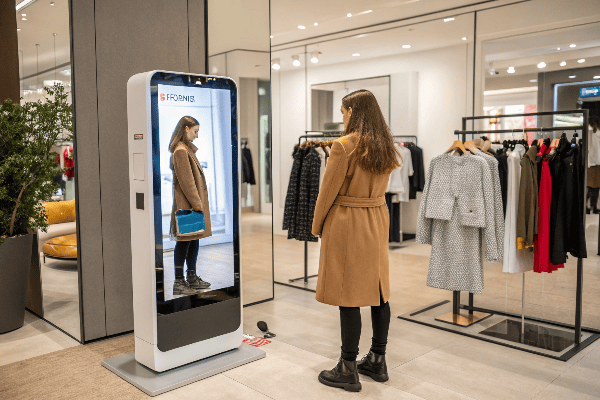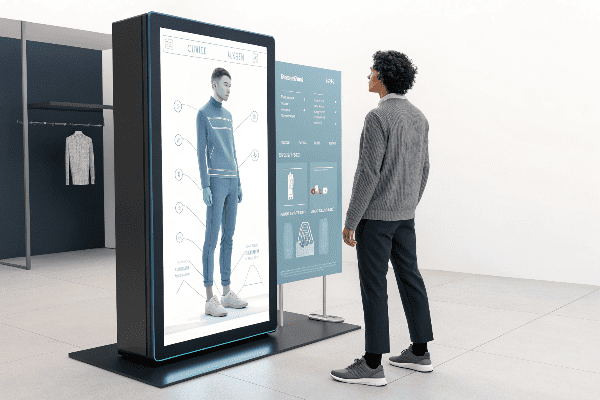Shopping for clothes online is convenient, but sizing issues lead to frustration and returns. Can AI-powered virtual try-ons solve this problem?
Yes, AI-powered virtual try-ons help shoppers find better-fitting clothes by analyzing body measurements, suggesting ideal sizes, and providing a realistic fitting experience. This reduces returns and improves customer satisfaction.

AI is transforming fashion retail, making online shopping more accurate and personalized. Let’s explore how virtual try-ons work, their benefits, and their challenges.
Table of Contents
- How Do AI-Powered Virtual Try-Ons Work?
- Can AI Improve Online Clothing Fit Accuracy?
- What Challenges Do AI Virtual Try-Ons Face?
- Conclusion
How Do AI-Powered Virtual Try-Ons Work?
Traditional online shopping lacks the ability to try on clothes before buying. How do AI-powered try-ons change that?
AI virtual try-ons use computer vision, augmented reality, and machine learning to simulate how clothes fit on different body types, helping shoppers make better choices.

AI and Computer Vision
AI analyzes body proportions to recommend the right fit.
| Technology | Function |
|---|---|
| Computer Vision | Scans images or videos to detect body shape and measurements. |
| Machine Learning | Learns from past purchases and customer feedback to improve size recommendations. |
| 3D Modeling | Creates realistic clothing simulations on a digital avatar. |
AI-powered systems scan a customer’s uploaded image or body measurements, then match them with clothing dimensions. This improves the chances of selecting the right fit.
The Role of Augmented Reality
Augmented reality (AR) enables shoppers to "wear" digital clothes.
| Feature | Benefit |
|---|---|
| Real-Time Fitting | Customers see how clothes fit before buying. |
| Interactive Experience | Shoppers can adjust angles and movements. |
| Reduced Returns | Fewer misfit purchases lead to lower return rates. |
By combining AI with AR, brands create an immersive shopping experience that closely mimics in-store try-ons.
Can AI Improve Online Clothing Fit Accuracy?
Online size charts often lead to confusion. Can AI fix these inconsistencies?
AI improves size accuracy by standardizing measurements, analyzing customer data, and offering personalized recommendations.

Reducing Size Inconsistencies
Different brands have different sizing standards. AI helps create a universal sizing guide.
| Problem | AI Solution |
|---|---|
| Brand-Specific Sizing | AI converts sizes between different brands. |
| Inconsistent Measurements | Standardized body scanning eliminates guesswork. |
| One-Size-Fits-All Issues | AI suggests custom fits based on individual proportions. |
Shoppers no longer need to rely on vague size charts. AI ensures they get the most accurate fit.
Personalized Size Recommendations
AI learns from customer preferences to provide better recommendations.
| Data Used | Impact |
|---|---|
| Past Purchases | AI predicts the best fit based on previous orders. |
| Customer Feedback | Reviews help improve accuracy over time. |
| Body Scans | Detailed measurements fine-tune recommendations. |
The more a customer shops, the better AI gets at suggesting sizes, improving the overall experience.
What Challenges Do AI Virtual Try-Ons Face?
Despite advancements, AI-based try-ons are not perfect. What are the major challenges?
AI virtual try-ons face limitations in accuracy, user adoption, and technical constraints, making widespread adoption slower.

Technical Limitations
AI systems still struggle with complex designs and fabric behavior.
| Challenge | Explanation |
|---|---|
| Fabric Texture Simulation | AI cannot perfectly replicate stretch and flexibility. |
| Lighting and Skin Tone Issues | Color accuracy may vary based on different lighting conditions. |
| Limited Body Shape Data | AI models work better for standard sizes than unique body types. |
Developers are working on improving AI’s ability to handle these issues, but full accuracy is not yet achieved.
Consumer Trust and Adoption
Many customers are hesitant to trust AI-based fittings.
| Concern | AI Solution |
|---|---|
| Privacy Issues | Brands must ensure secure handling of body scan data. |
| Skepticism Toward Accuracy | Improved AI algorithms enhance fitting precision over time. |
| Limited Awareness | Marketing and education help increase user confidence. |
Overcoming these barriers is crucial for AI virtual try-ons to become a mainstream shopping tool.
Conclusion
AI-powered virtual try-ons are revolutionizing online fashion by improving size accuracy and shopping experiences. While challenges remain, advancements in AI and AR are shaping the future of digital fashion.


